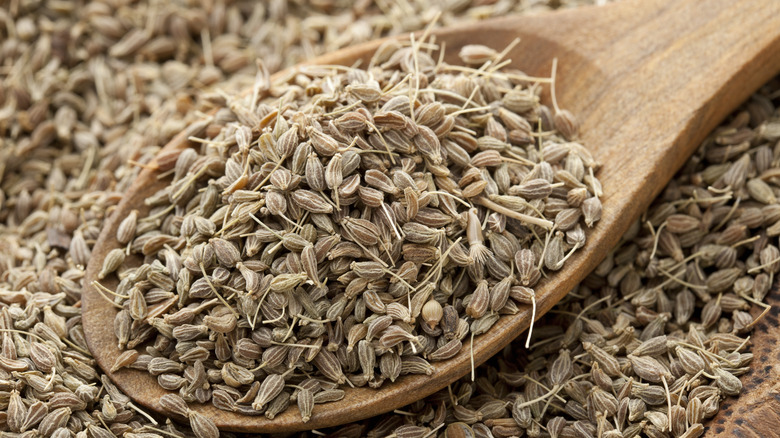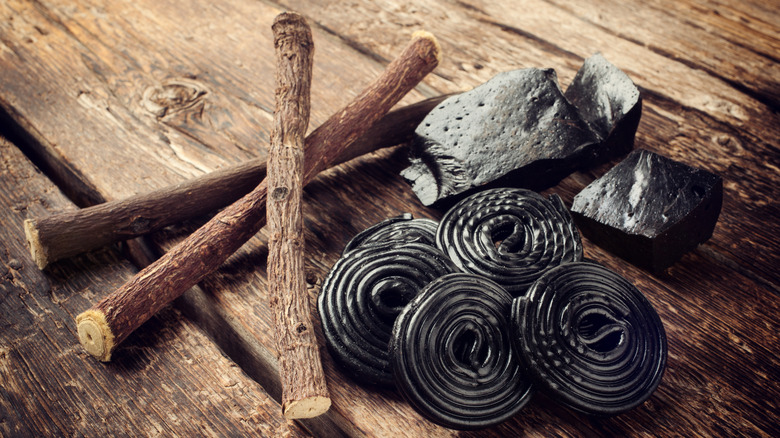The Pungent Difference Between Anise And Licorice Flavors
Have you ever tasted a cocktail or tea infused with anise seed, and noticed the striking flavor reminiscent of licorice? In fact, anise and licorice both contain the compound anethole, which is attributed to the signature earthy candied aroma and flavor bite of licorice. For this reason, anise is often compared (and even confused) with licorice because of its similar taste and fragrance, but there are a few differences that set anise seed's taste apart, especially its pungent spiciness.
Anise's spiciness is combined with a subtle licorice-sweetness and a refreshing nature making it ideal for incorporating into a variety of sweet and savory cooking applications as a ground or whole spice seed. Its flavor is often described as licorice but with an added boldness. Licorice generally has a sweeter flavor due to the compound, glycyrrhizin, which has a highly concentrated sweetness. Since it's a root, licorice also has a bitterness to it (sometimes described as metallic), with earthy, herbal qualities.
Anise is a seed, while licorice is an herbal root
Though some might confuse anise with licorice, or further with star anise (which is even bolder), anise is actually from an entirely different plant and plant family altogether — a plant family that includes the likes of other fragrant ingredients like parsley, fennel, and dill. Anise seeds, which are small and tan-brown, come from a flowering plant called Pimpinella anisum. With origins in the Mediterranean and Southeast Asia, the plant has since been cultivated and the seeds enjoyed for culinary and medicinal uses all across the world, in regions including Egypt, the Middle East, and Italy.
Licorice, native to Southern Europe and Western Asia, also has long been cultivated widely for extracts, herbal remedies, and, of course, chewy candies. Though anethole oil is a compound commonality between licorice and anise (and also is found in fennel), licorice is derived from a perennial plant called Fabaceae, which belongs separately to the pea family. The plant can grow over three feet high, and its roots are harvested and dried or boiled to extract a dark flavorful juice, used to create what we know (and either love or hate) as licorice.
Culinary uses for each flavor
Anise's fragrant licorice aroma and taste, paired with its pungency lend it to a variety of culinary uses, including spice rubs, stews, and a variety of baked goods. You may not know it, but anise seed is commonly used to make flavorfully spicy and floral biscotti. It's also kneaded into yeasty doughs like Venezuelan golfeados, sticky buns filled with sugary syrup, anise, and mild cheese. Since anethole oil is highly soluble in alcohol, anise is also commonly featured in spirits and aperitifs like absinthe and French pastis.
Both anise and licorice have historically been used for natural herbal remedies and teas. Licorice, however, is perhaps best known in the United States as red candy twisted into ropes or bite-sized pieces. Though some candy-makers do use licorice root extract juice, boiled down with starch and sugar, to make the infamously chewy candy, in the states, anise (or even star anise) extract is commonly used to impart the licorice flavor. In other countries like Finland and Scandinavia, which use the root to make black licorice confectionery, the taste can vary widely from simply sweet — in fact, it's often balanced with a nice saltiness from the ingredient ammonium chloride.
Licorice has other uses beyond candy though. The root can be boiled down to impart complexity to vegetable soup or hearty beef stew. Add either anise seed or licorice (or both) when making homemade root beer, and see for yourself all the flavor opportunities the ingredients have to offer.


